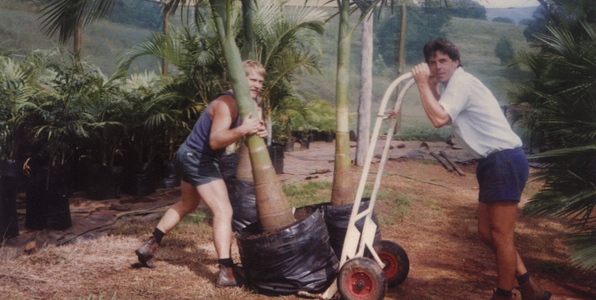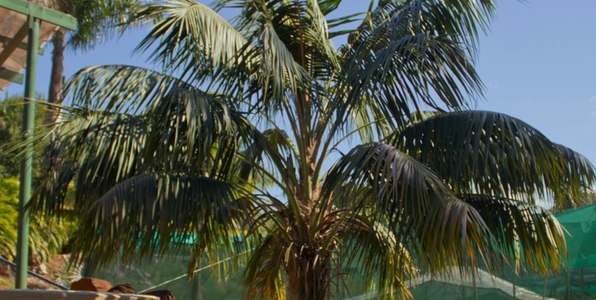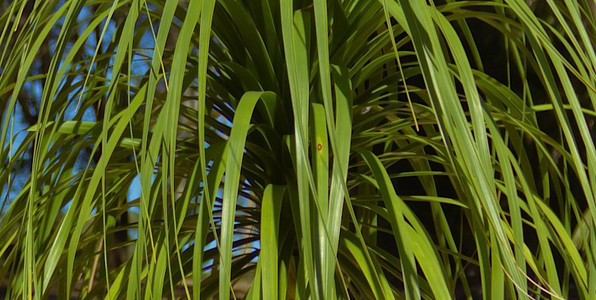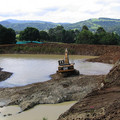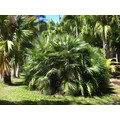Jump to page 2 | 3 | 4 | 5 | 6 | 7 | 8 |
Some of the Common Naturally Occurring Australian Palm Trees
| Alexandra palm: | Archontophoenix alexandrae comes from the QLD coast to Cape York and grows to 30m. | |
| Atherton palm: | Laccospadix australasica comes from the Atherton Tablelands and grows to 8m.: | |
| Australian Arenga: | Arenga australasica comes from Cape York and the top of the NT coastand grows to 20m. | |
| Australian Fan palm: | Licuala ramsayi comes from the rainforests of north QLD and grows to 20m. | |
| Bangalow palm: | Archontophoenix cunninghamiana comes from the Irrawarra to Mackay and grows to 25m. | |
| Black palm: | Normanya normanbyi comes from Cairns to Port Douglas and grows to 20m. | |
| Cabbage palm: | Livistona Australis comes from the Fraser Is coast to the eastern Victorian coast. | |
| Carpentaria palm: | Carpentaria acuminate comes from the top of NT and grows to 30m. | |
| Coconut palm: | Cocos nucifera comes from Fraser Is to Cape York and grows to 35m. | |
| Curly palm: | Howea belmoreana comes from Lord Howe Is off NSW and grows to12m. | |
| Darwin palm, : | Ptychosperma bleeseri comes from around Darwin and grows to 12m. | |
| Dwarf Fan palm: | Livistona muelleri comes from inland north QLD and grows to 6m. | |
| Fan palm: | Livistona benthamii comes from the top of NT, Cape York and New Guinea and grows to 20m. | |
| Fishtail palm: | Caryota albertii comes from Cape York and grows to 20m. | |
| Foxtail palm: | Wodyetia bifurgata comes from far north QLD and grows to 20m. | |
| Florence Falls palm: | Hydriastele wendlandiana comes from the top of the NT and Cape York and grows to 15m. | |
| Gebang palm: | Coypha utan comes from the top of NT and Cape York and grows to 25m. | |
| Kentia palm: | Howea forsteriana comes from Lord Howe Is and grows to 15m. | |
| Macarthur palm | Ptychosperma macarthurii comes from around Darwin and Cape York and grows to 8m. | |
| Mataranka palm: | Livistona rigids comes from the Lawn Hill National Park and Mataranka in the NT and grows to 20m. | |
| Mt. Lewis: | Archontopoenix purpurea comes from Mt Lewis north QLD. It’s a close relative of the Alexandra and grows to 6 to 8m. | |
| Norfolk Island Palm: | Rhopalostylis baueri comes from Norfolk Is and grows to 16m. | |
| Ribbon Fan palm: | Livistona decipiens is found in pockets along the coast of QLD and grows to 15m. | |
| Red Cabbage palm: | Livistona mariae comes from around Alice Springs and grows to 20m. | |
| Sand palm: | Livistona humilis comes from the top of the NT and grows to 6m. | |
| Solitare palm: | Ptychospermia elegans comes from Noosa Heads and up the coast of QLD and grows to 15m. | |
| Umbrella palm: | Hedyscepe canterburyana comes from Lord Howe Is and grows to 10m. | |
| Walking Stick palm: | Linospedix monostachya comes from the subtropical rainforests and grows to 2 to 3 m.: | |
Playing Horticultural Cupid: The In's and Out's of Pollination
Pollination, which may be loosely defined as the depositing of pollen to ensure plant fertilization, is a crucial factor in the growth and wholesale of plants in Australia. However, due to several unique geological qualities, as well as the presence of unique wildlife, the entire process has become somewhat more complex. These reasons will be explored shortly in the article to follow.
Geological stability is the defining factor of Australia's unique fauna and flora. Unlike neighbouring New Zealand, which was shaped by massive geological upheavals, geologists estimate that the geological make up of the continent has remained the same for approximately 80 million years. This unparalleled stability has led to very distinctive soil types, which in turn has allowed for the growth and development of some of the world's most amazing plant life.
In directly causal fashion, animals developed alongside these special plants to take advantage of the food on offer. Australia is world renowned for one-of-a-kind animals, from kangaroos to koalas. And these animals are, in general, responsible for pollination of plants. Although it is true that some plants have developed bisexual methods of what is essentially self-pollination, the animal vectors are the favored reproductive strategies for most plants.
Whilst all of this localized diversity is a pleasure to Australian residents and a source of national pride, it has undoubtedly led to issues regarding the pollination of plants, particularly in the commercial sector. While new developments in the engineering of customized hybrid plants have led to some beautiful new flowers, the natural role of flowers in particular has diminished.
Flowers serve as advertisements to potential pollinators. As a reward for their visiting the flower, they would receive pollen and nectar. However, engineered plants lack the rewards that natural plants offer, and so potential pollinators are not as attracted. Once again, the domino effect of such a problem is fairly self-evident - no pollinators leads to no new pollination, which leads to diminished growth patterns and ultimately, extinction of the species of plant and insect.
Another area of concern, particularly in Australia, is the decreasing number of certain key bat and bird species. Birds in particular spread seed over vast distances via their droppings, allowing plant species to reach out over larger geographical sights. Bats spread seed in much the same way, as they are attracted to very specific, strong-smelling plants which flower at night.
Their droppings help to spread the seed of such plants. However, increasing areas of destruction for agriculture and housing lead to the elimination of these types of plants. Several animals, such as possums and specific kinds of beetles native to Australia, are facing extinction as their habitat shrinks on a daily basis.
In much the same way as the genetic flower hybrids are leading to a subtle slowing in the efficacy of certain key pollinators, widespread destruction of key ecosystems is literally forcing pollinators to adapt to new conditions which they simply cannot cope with.
The situation does indeed seem dire. Unique geological conditions have given rise to native animals with highly evolved pollination strategies, but due to human ingenuity and simultaneous carelessness, this balance is being threatened.
Studies in Argentina, America and England have suggested that the life cycle of bees has been affected by similar issues to the point where their numbers have decreased by as much as 50% in just 20 years. Feral honeybees (Apis mellifera) are threatening native bees, which has a direct and severe impact on plant pollination.
There is hope for the future if commercial plant dealers and farming communities co-operate with government in order to try and slow these worrying trends. Australia is recognized for forward thinking regarding the preservation of local flora and fauna via botanical gardens and reserves, but this pride needs to be instilled in every citizen.
Legislation to protect larger plants such as palms also needs to be passed to ensure that some of Australia's amazingly well-adapted wildlife will always have a home. And commercial plant dealers may have to take a step back with genetic development and do things the traditional way - pollinating plants themselves until nature's pollinators are able to do the job themselves.
Something as simple as a paintbrush may be used to ensure successful reproduction of plants. In an industry that is proudly selling natural, indigenous plants and products, many believe that a simple return to traditional techniques will help Australia to correct its natural balance and continue to prosper and grow as a bastion of flora and fauna.
Ways to Enforce Weed Control and Keep Your Palm Safe
Most palms are relatively easy to maintain. But like most plants, weed growth is a prevalent and annoying problem. It may seem like no matter how often you take the time to pull weeds out in your garden, they always grow back and flourish.
Weeds are basically just like the plants that you're caring for in your garden. They need the same basic things just like any palms and other plants: sunlight, water and nutrition. As long as they have everything they need, best believe that they will keep on thriving.
Useful Tips on How to Properly Move Large Palms
In the case of gardening, there will be instances when you must move your palms in the ground. The reasons are plenty. You may need to make more space; you may need to improve the spacing between them for better growth or you have just decided that it is more aesthetically pleasing that way. Whatever your reason for transplanting your palm, you must follow some basic instructions.
Luckily palms are one of the easiest plants to move because of their large and fibrous root ball as opposed to trees with long taproots. They are compact and may be lifted out like a ball. The palms are also known for recovering quickly after a move.
During the growing season is the best time. Take as much soil as possible around the root ball. Some palms will not survive moving such as the Bisimarkia's and Bangalow's. Alexandra's are good to move along with Windmills, Golden Canes and Triangles.
Consider the location where you will be moving your palm
Take into consideration the size the palm might grow into and if the view will be compromised.
Prune any damaged or worn out fronds and water the palm's roots thoroughly right before you plan the move.
Start digging a trench around the palm
Once the trench is deep enough, dig out as large a root ball as you can manage. Push the plant gently until it has tipped over. With the help of a crowbar and shovel, pry out the rest of its root system until you get it completely out of the hole. It is inevitable to cut into some of the roots.
You may need up to three or four people to help you lift out the palm from the hole depending on the size. It will be handy to have a wheelbarrow or a cart for easy transportation. If the palm is large and you have the money, employ a small or large excavator.
Wrap the roots of your Palm
If the transplanted palm involves moving via a vehicle, it is important to wrap the roots in hessian cloth. Spray the hessian with water to ensure that the roots stay most while in transit. Bring together all the palm fronds and wrap them together using twine.
Water the hole well
Before planting the palm into its new location, make sure that the new hole is watered. Place the palm into the hole at the same depth as it was growing before. Add water to the hole after you have planted it. Then pack soil around the palm tightly. If the palm is tall (4 metres or more) tie up the fronds around the palm trunk when re planting the palm. Leave them tied for a couple weeks after re planting. This will reduce transpiration and reduce the palm moving in the wind. The palm's roots need to re connect and grow back into the soil. To also assist with root re growth , compact the soil around the base of the re planted palm. Even better with large and expensive palms use a commercial soil compactor to compress the soil. Establish a drip watering system at the base of the palm and leave it running for the first couple weeks.
Build a stake using three posts to keep the tree in place and secure
You can use metal star pickets or stakes made out of timber. Use your hessian tape to keep them in place.
Keep the soil moist
Remember to water daily to keep the soil moist and to help its roots establish themselves in their new location. Water the roots with a seaweed solution this will help promote root development. It will take about three weeks before you can cut down on watering to about twice or thrice a week depending on the temperature. Once you have stabilized your palm into its new place, you may begin to fertilize.
How to Identify Other People's Australian Palms
There are over 25000 species of palms in tropical, subtropical, and warm temperate climates around the world. Over 50 of these are found in Australia. These flowering plants are usually characterized by an un-branched stem (there are some exceptions) and large leaves (fronds) arranged around the top. They are extensively cultivated and widely used in landscaping due to their exotic appearance.
There are two main types of palms, palmate and pinnate. Palmate palms have large, fan-like fronds, while pinnate palms have fronds that resemble feathers. Both types of leaves are usually spirally arranged at the top of the stem, and the flowers are usually small and mature into a single-seeded fruit. While many species of palms are sold and can grow in Australia, we are going to focus on some of the more common native species:
Alexandra Palm (Archontophoenix Alexandrae)
This palm is a native along the coast of Queensland and the tip of the Cape York Peninsula. It can grow up to 30 metres, but is significantly smaller when raised in a garden. It has a pale green crown shaft and a grey to greenish-grey trunk. Its fronds are 2 to 3 metres long, with white flowers and red fruits.
Australian Cabbage Palm (Livistona Australis)
This is a popular landscaping palm due to its tolerance to various weather conditions, including frost. It is found on the eastern coast of Australia and grows up to 30 metres tall. It features a grey trunk; palmate leaves approximately 3 metres long, yellow flowers, and reddish-brown fruits.
Australian Fan Palm or Wedge Leaflet Fan (Licuala ramsayi)
This is an amazing understory rainforest palm from nth QLD where they grow to 15 metres. They will also grow south into northern NSW and can be grown further as an indoor plant. They are slow growing and need moisture and warmth. Worth the effort if you can grow one.
Bangalow Palm (Archontophoenix cunninghamiana)
This palm is very similar to an Alexandra but the trunk is thinner and the colour under the leaves is green the same as on top of the leaves .It grows to 25 metres. The Alexandra has a more silvery colour on the underside. The Bangalow is cold tolerant and ok for Melbourne, the Alex is not. They will cross pollinate if they are flowering together producing " Albangs or Bangalex's"
Black Palm (Normanya normanbyi)
This palm grows about 20 metres tall and is found in the North Queensland rainforest. It has a grey crown shaft and a light grey, smooth and slender trunk that turns almost black as the palm ages. It has 3 metre, pinnate fronds, white flowers, and yellow fruit.
Carpenteria Palm (Carpentaria acuminate)
This palm is found in the Northern Territory. It is a tall (30 metres), solitary palm that can reach maturity in 6 years under the right conditions. It has a grayish-green crown shaft and 4 metre long, dark green, pinnate, re-curved fronds. It features white and scarlet flowers.
Coconut Palm (Cocos nucifera)
This palm features a large palm head and massive coconut fruits. It is native to Queensland and tropical areas of the Western Pacific and can grow to be 35 metres tall. It has a grey trunk, cream flowers, and pinnate fronds.
Fan Palm (Livistona muelleri)
This palm grows to approximately 16 to 25 metres, but remains much smaller in gardens (3 to 4 metres). It is native to the Northern Territory and the Cape York Peninsula. It has a brown trunk, bluish-black fruit, and large, palmate fronds.
Fishtail Palm (Caryota albertii)
This palm is a large, clumping palm that grows to be 5 to 10 metres tall and approximately 4 metres across. It has a light green to grey trunk, bi-pinnate fronds with widely spaced leaf nodes, cream flowers, and dark purple fruit. Its natural habitat is the Cape York Peninsula.
Florence Falls Palm (Hydriastele wendlandiana)
This palm grows 7 to 20 metres tall in the top end of the Northern Territory and the eastern coast of the Cape York Peninsula. It has a whitish-green crown shaft and clusters of 2 to 3 slender stems rising above a dense cluster of cane-like stems. The fronds are broadly pinnate, and it has red fruits on short stalks located below the crown.
Foxtail Palm (Wodyetia bifurgata)
This palm is native to Queensland. It is suitable for tropic, subtropics, and temperate areas. It is a single trunk palm that grows to 15 metres with a pale green crown shaft and pinnate leaves. It features feathery white flowers and large bright orange fruit.
The leaves are surated at the tips and along with the arching frond, look like a foxes tail
Kentia Palm (Howea forsteriana)
This palm is native to Lord Howe Island. It is a solitary, medium-sized (up to 15 metres) palm with brown flowers and orange to red fruit. It has a brownish-grey trunk and large fronds.
Solitaire Palm (Ptychospermia elegans)
This palm grows up to 10 to 12 metres and is found in Queensland. It has a green crown shaft and a greenish-grey stem. It has a head of semi-erect, pinnate fronds and produces white flowers and bright red fruit.
Umbrella Palm (Hedyscepe canterburyana)
This palm grows up to 10 metres tall with a 1-metre long, silvery crown shaft. It has a grayish-green trunk, 3-metre long re-curved fronds, and orange to yellow flowers. Umbrella Palms also feature deep red fruits that are 4 centimeters long and densely bunched below the crown shaft.
The Basics of the Ponytail Palm (Beaucarnea recurvata)
Ponytail Palms may look quirky and amusing but this plant is on track to being one of the most popular varieties of garden and indoor palms. It is not a true palm.
The Ponytail Palm is characterized by its 6 inches long and 1 inch wide leaves that look like ribbons emerging like a fountain from the branches in a downward curl making it look like an onion. It has a very graceful appearance, making it a favourite among landscapers and gardening enthusiasts. When it eventually flowers and seeds the seed head is a spectacular pinkish colour.
